Mehndi, also known as henna, has been a significant cultural tradition for centuries. Its intricate designs, drawn with natural henna paste, adorn hands and feet, transforming them into beautiful canvases of art. Mehndi is not just a form of decoration but a symbol of celebration, love, and cultural heritage. Across weddings, festivals, and special occasions, full hand mehndi design holds an esteemed place, signifying happiness and prosperity.
In particular, full-hand mehndi designs stand out for their elaborate patterns that exude grandeur. They often narrate stories through intricate motifs and are perfect for those who seek detailed, mesmerising artwork. This article explores the significance of full-hand mehndi and presents stunning design ideas tailored for various occasions, ensuring that your hands become a centrepiece of admiration.

Significance of Mehndi in Different Cultures

Symbol of Auspiciousness
In Indian culture, mehndi is an integral part of ceremonies like weddings, Karwa Chauth, and Eid. Its application is considered auspicious and believed to bring good fortune and happiness. The deeper the colour of the mehndi, the stronger the love and bond it symbolizes between couples.
Expression of Art
Mehndi designs are an art form that has evolved over centuries. From traditional motifs to modern minimalist patterns, they represent a fusion of creativity and cultural expression. Each design carries a unique significance, reflecting the personality and emotions of the wearer.
Healing Properties
Henna paste is derived from the leaves of the Lawsonia plant, known for its cooling properties. In many cultures, mehndi is applied not only as decoration but also for its therapeutic benefits, such as relieving stress and cooling the body.

Full-Hand Mehndi Design Ideas for Every Occasion
Bridal Full-Hand Mehndi Design

Bridal mehndi is the epitome of intricacy and beauty. These designs typically cover the entire hand, extending to the arms, and often include motifs like peacocks, lotus flowers, and paisleys.
The artistry involved in creating these designs is a testament to the skill and creativity of Mehndi artists, who spend hours perfecting each detail to ensure the bride’s hands are adorned with stunning patterns that complement her bridal attire.

Intricate Paisley Patterns

Paisleys are a classic element in bridal mehndi. When combined with floral patterns, they create a timeless design that exudes elegance. The swirling paisley motifs symbolize fertility and luck, making them a popular choice for brides. These patterns can be customized to include intricate details, such as delicate dots and lines, adding depth and texture to the design.

Storytelling Designs
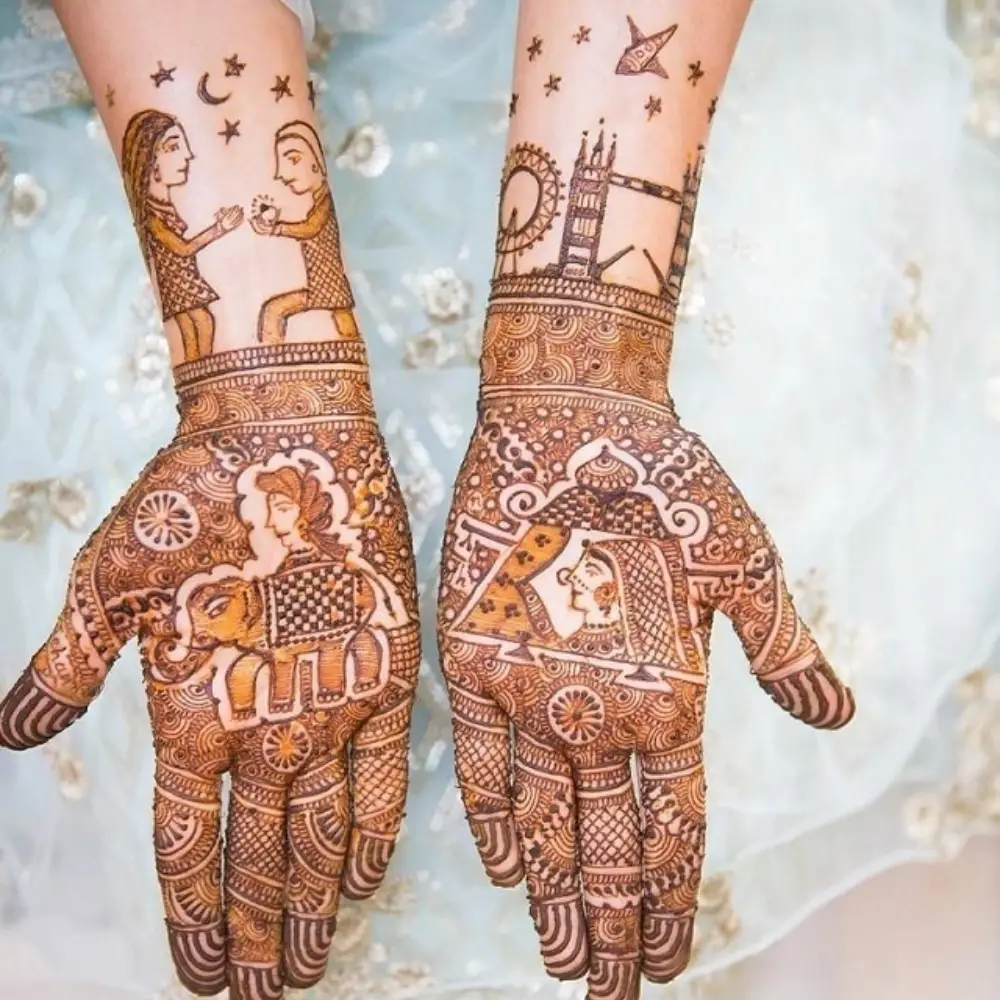
Many brides opt for mehndi which narrates their love story through personalized elements, such as portraits of the couple, wedding dates, or initials. This creative touch adds sentimental value and makes the Mehndi experience truly unique.
These designs often incorporate symbols of love and commitment, such as hearts or infinity signs, to reflect the couple’s journey and future together.

Mandala-Inspired Art

Mandala patterns are not only visually stunning but also symbolize unity and harmony. A series of mandalas intricately woven across the hands creates a balanced, symmetrical design.
The circular nature of mandalas represents the cycle of life and eternity, making them a meaningful choice for bridal mehndi. These designs can be further embellished with small geometric shapes or floral motifs to enhance their beauty and significance.

Festive Full-Hand Mehndi Design

Festivals like Diwali, Eid, and Navratri call for celebratory mehndi that are vibrant and intricate but not as elaborate as bridal designs. These occasions provide an excellent opportunity to showcase creativity and embrace cultural traditions through beautiful mehndi art.
Arabic Floral Trails

Arabic designs, known for their bold and flowing patterns, often incorporate floral trails that run across the hands. These are perfect for festivals as they are elegant yet relatively quick to apply.
The floral trails symbolize beauty and growth, making them an ideal choice for festive celebrations. They can be further enhanced with small leaves or vines, adding depth and continuity to the design.

Geometric Patterns
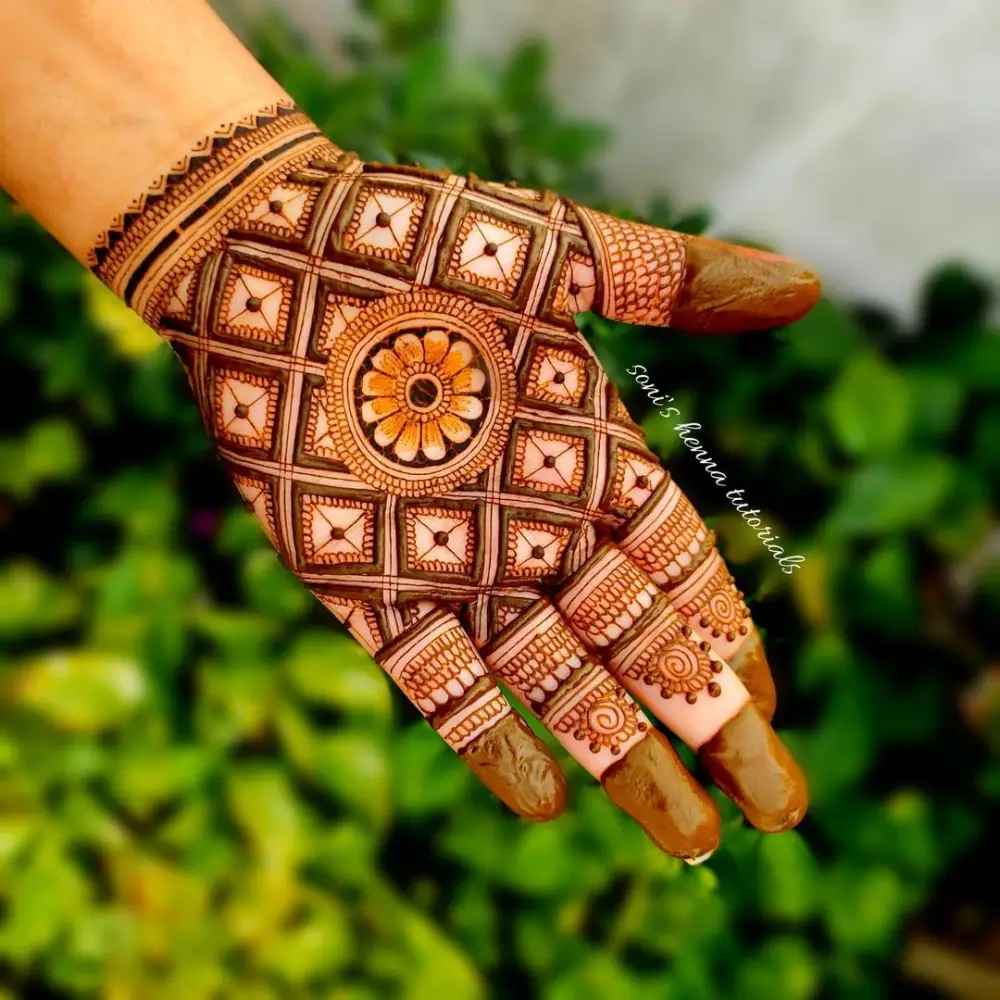
Geometric shapes like hexagons and diamonds, combined with traditional motifs, give a modern twist to full-hand designs. These are ideal for those who prefer a contemporary look. The symmetry and balance of geometric patterns reflect harmony and precision, resonating well with the festive spirit. They can be customized with intricate detailing or bold outlines, offering versatility in design.

Glitter and Color Infusion
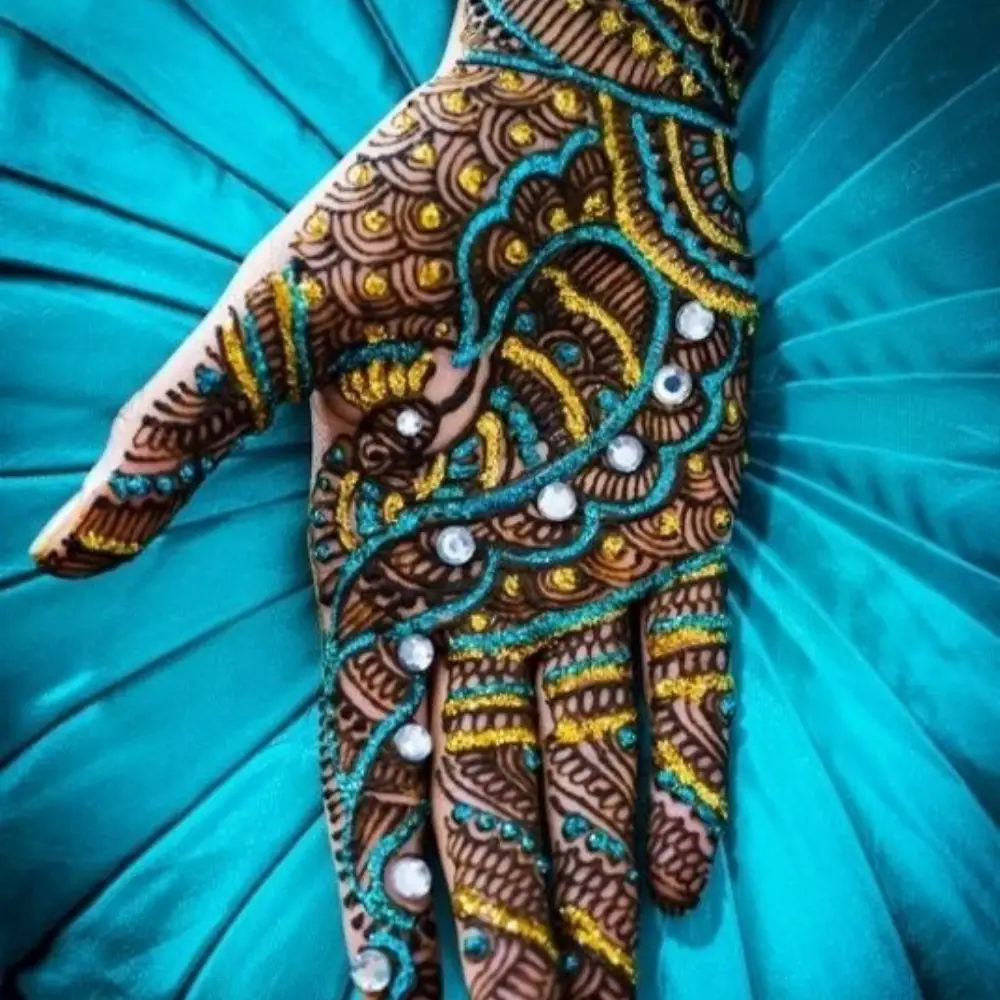
Adding glitter or coloured henna to the designs enhances the festive vibe, making the patterns stand out during celebrations. This infusion of colour adds a playful and lively touch, perfect for festive gatherings.
Glitter can be strategically applied to highlight certain areas, creating a dazzling effect that catches the eye. Coloured henna offers a unique contrast, allowing for creative expression and personalization in Mehndi art.

Minimalistic Full-Hand Design

For those who prefer subtle elegance, minimalistic designs are a perfect choice. They focus on clean lines and spaced-out motifs, offering a refined and sophisticated look.
Mandala with Negative Space

A single large mandala on the palm, surrounded by minimalistic patterns, creates a striking design. The use of negative space enhances the beauty of the central motif, allowing it to stand out prominently.
This approach not only highlights the mandala but also brings a modern twist to traditional patterns, making it suitable for both casual outings and formal events.

Leafy Vines

Simple leafy trails running across the fingers and hands offer a natural and graceful look. These designs are suitable for casual events or office parties, providing just the right amount of adornment without being overwhelming.
The elegance of leafy vines lies in their simplicity, making them versatile for various occasions. Whether it’s a family gathering or a festive celebration, these designs add a touch of nature-inspired beauty to your hands, making them look effortlessly chic.

Traditional Full-Hand Mehndi Design

Traditional mehndi designs are timeless and deeply rooted in cultural heritage. They often include motifs like elephants, Kalash (sacred pot), and mango leaves.
Peacock Motifs

The peacock is a symbol of grace and beauty, making it a popular choice in traditional mehndi. When combined with detailed feather patterns, it creates a mesmerizing design. These designs not only add elegance but also convey cultural richness, often enhanced with intricate detailing that highlights the peacock’s majestic feathers and vibrant presence.

Temple Architecture Inspired

These designs draw inspiration from Indian temple architecture, featuring intricate carvings, domes, and pillars. They are perfect for religious ceremonies. The complexity of these designs mirrors the grandeur of ancient temples, offering a spiritual depth that resonates with cultural and religious sentiments, making them ideal for auspicious occasions.

Baraat Scenes

Depicting a traditional wedding procession (baraat) in the mehndi is a unique way to honour cultural heritage. This design is often chosen for weddings and related functions. Baraat scenes bring the vibrancy of Indian weddings to life on the hands, showcasing elements like musicians, dancers, and the groom on horseback, encapsulating the joyous spirit of matrimonial celebrations.

Contemporary Full-Hand Mehndi Design

Contemporary designs blend traditional elements with modern artistry, catering to today’s generation. These designs are perfect for those who seek a balance between classic and current trends, offering a fresh perspective on traditional mehndi.
Abstract Patterns

Abstract art, featuring irregular shapes and lines, creates a bold and unique look. These designs appeal to those who enjoy experimenting with new trends. Abstract patterns allow for creative freedom, making each design distinct and personal.
They often incorporate asymmetrical shapes, unexpected angles, and dynamic lines, resulting in a captivating and modern appearance. Abstract Mehndi’s designs are ideal for fashion-forward individuals who want to make a statement at social gatherings or casual events.

Modern Fusion
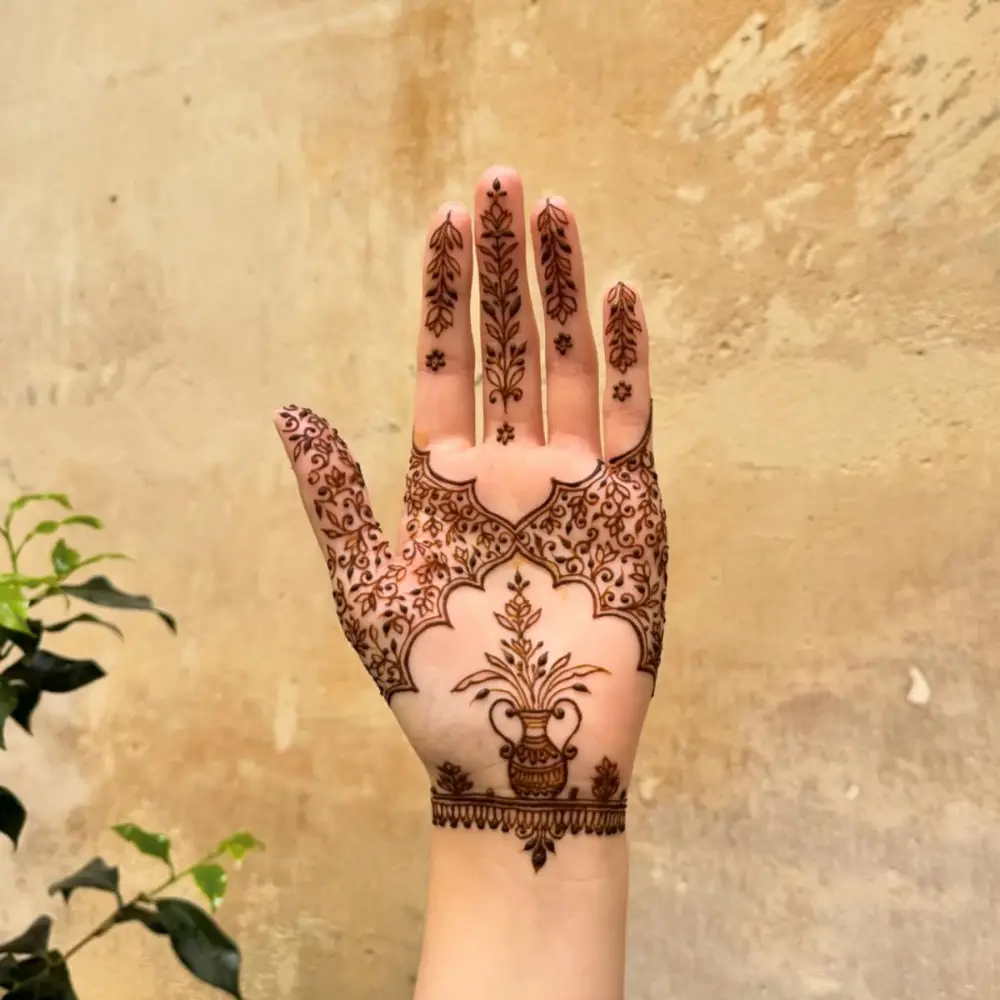
Fusion designs combine Indian motifs with international patterns like Moroccan or tribal art. This cross-cultural approach adds versatility and charm. Modern fusion designs often feature a blend of intricate Indian floral patterns with bold geometric shapes from other cultures.
This amalgamation creates a harmonious design that resonates with the globalised world. Such designs are perfect for multicultural events, showcasing a blend of heritage and contemporary style.

Jewelry-Inspired Designs

Designs that mimic jewellery, such as bracelets and rings, are a modern take on full-hand mehndi. These patterns are chic and complement both traditional and Western attire. Jewellery-inspired mehndi designs often feature elaborate chains, pendants, and gem-like motifs, giving the illusion of wearing intricate jewellery. This style is particularly popular for events

Occasion-Based Themes Full Hand Mehndi Design

Full-hand mehndi can also be tailored to match specific occasions or themes, offering personalised designs that resonate with the essence of each event.
Baby Showers

Mehndi for baby showers often includes motifs like cradles, baby footprints, and cute animals, adding a playful touch. These designs can be further personalized with elements like baby bottles, rattles, or even the expected baby’s name or initials. The use of soft, delicate patterns symbolizes the joy and excitement of welcoming a new life.

Engagements
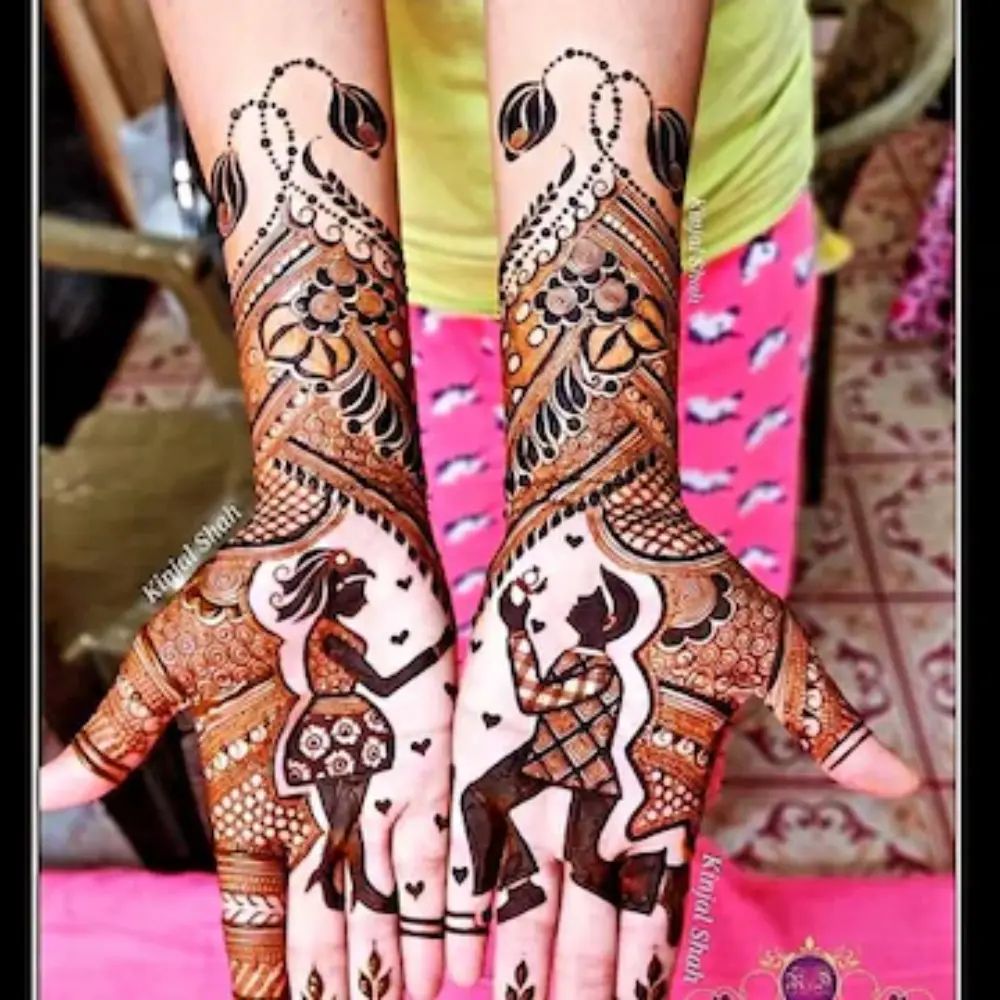
Engagement mehndi typically features intricate rings or hearts, symbolizing the couple’s bond. Adding the initials of the couple is a popular trend. These designs can be enhanced with romantic elements like lovebirds, infinity symbols, or intertwined vines, representing the eternal bond. The mehndi can also include the date of the engagement, serving as a beautiful reminder of the special day.

Tips for Choosing the Perfect Full-Hand Mehndi Design
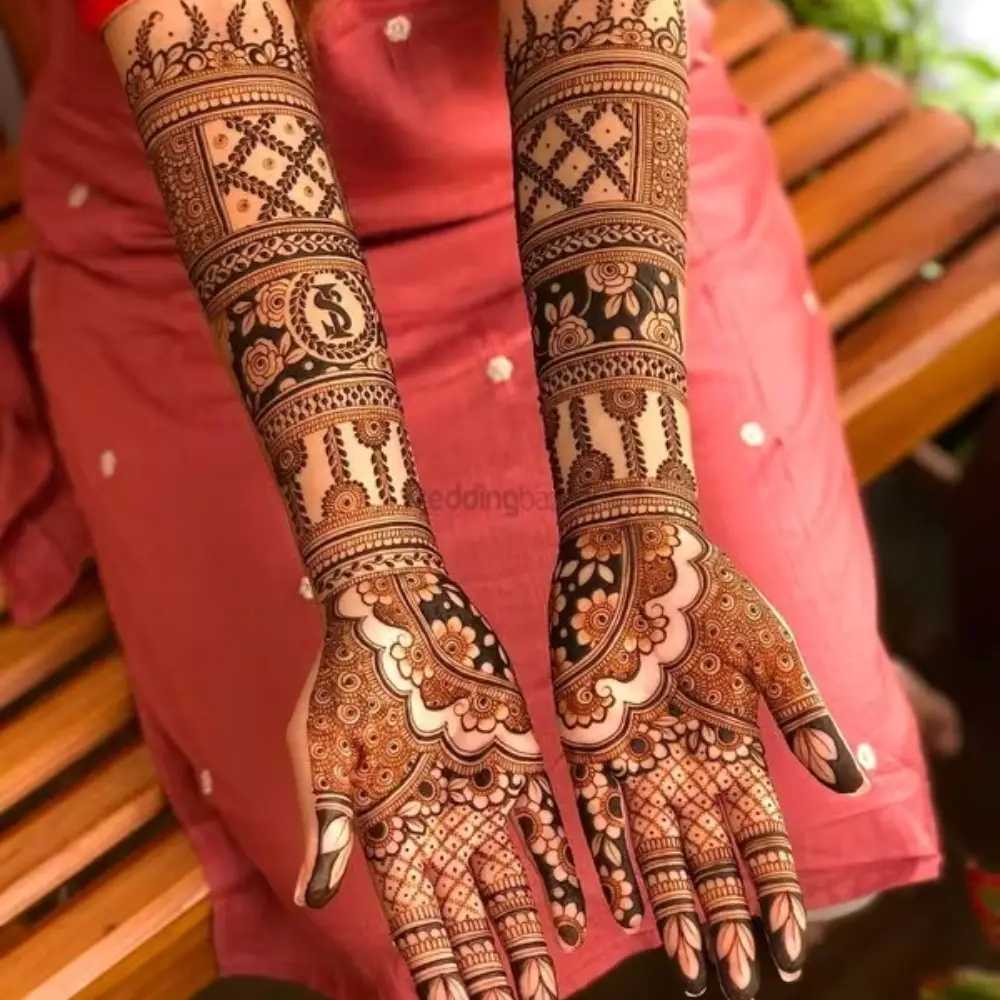
Understand the Occasion
Choose a Mehndi design that fits the event. For weddings, select elaborate patterns, while casual celebrations call for simpler styles. Traditional motifs are ideal for cultural festivals or religious ceremonies, whereas modern parties may benefit from contemporary designs.
Understanding the event’s context helps ensure your mehndi complements the overall ambience and attire.
Know Your Style
Opt for designs that reflect your personality, whether traditional or contemporary. If you prefer classic elegance, traditional motifs like paisleys may suit you. For a modern look, abstract or geometric patterns could be more appealing. Factor in the placement and size of your design to enhance your overall look and express your individuality.
Opt for Experienced Artists
Choose a skilled Mehndi artist for a design that is precise and stunning. Their expertise significantly influences the final result, as experienced artists bring technical skill and creative flair. Investing in a reputable artist can transform your mehndi into a piece that garners appreciation and enhances your overall appearance.
Experiment with Add-Ons
Enhance your mehndi with glitter, rhinestones, or coloured henna for added vibrancy. Glitter adds sparkle, rhinestones mimic jewellery, and coloured henna allows for creative expression by matching your outfit. These embellishments elevate your mehndi’s beauty and provide a personalized touch.

Mehndi Aftercare Tips

Keep the Mehndi Paste On for a Longer
Allow the paste to dry naturally for at least 6-8 hours to ensure a darker stain. This duration allows the henna to release its dye fully, ensuring a rich and deep colour that can last for weeks. For even better results, some people prefer to keep the paste on overnight, covering it with a breathable material to protect it while sleeping.
Avoid Water
Refrain from washing your hands immediately after removing the paste. Use a gentle oil to scrape it off instead. Water can dilute the stain, reducing its intensity. Natural oils like coconut or olive oil are excellent choices for this purpose, as they are gentle and nourishing.
Apply Lemon and Sugar Mixture
Dab a mixture of lemon juice and sugar onto the dried mehndi to enhance the colour. This traditional method helps in fixing the dye, making the stain more robust. The sugar acts as a sealant, keeping the mehndi moist, while the lemon juice acts as a catalyst, intensifying the colour.
Avoid Harsh Soaps
Use mild soap and avoid scrubbing to maintain the mehndi stain for a longer time. Harsh soaps and vigorous scrubbing can strip the skin of its natural oils, causing the mehndi to fade faster.
Also Read: Simple Mehndi Design Ideas for Brides and Festive Occasions

Frequently Asked Questions (FAQs)

Conclusion:
Full-hand mehndi designs are not just about beauty; they are a celebration of culture, creativity, and emotion. Whether you are a bride-to-be, a festival enthusiast, or someone looking to add charm to a special occasion, there is a design that speaks to your unique style and personality.
By blending traditional motifs with modern artistry, full-hand mehndi designs continue to evolve, offering limitless possibilities for self-expression. Embrace the art of mehndi and let your hands tell a story of elegance and grace.
Please let us know in our comments section below or email us via the contact page at “The Simple Indian,” which full-hand mehndi design you like the most! Remember, we are always here to answer your questions and hear your suggestions. Become a part of “The Simple Indian” family today!
Table of Contents
Full Hand Mehndi Design
- Significance of Mehndi
- Mehndi Design Ideas for Every Occasion
- Festive Full-Hand Mehndi Design
- Minimalistic Full-Hand Design
- Traditional Full-Hand Mehndi Design
- Contemporary Full-Hand Mehndi Design
- Occasion-Based Themes Full Hand Mehndi Design
- Tips for Choosing the Perfect Design
- Mehndi Aftercare Tips
- FAQs
- Conclusion
- Leave a Comment




